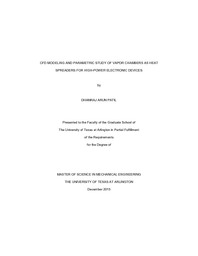CFD MODELING AND PARAMETRIC STUDY OF VAPOR CHAMBER AS HEAT SPREADERS FOR HIGH-POWER ELECTRONIC DEVICES
| dc.contributor.advisor | Agonafer, Dereje | |
| dc.creator | Patil, Dhanraj Arun | |
| dc.date.accessioned | 2016-01-27T21:18:00Z | |
| dc.date.available | 2016-01-27T21:18:00Z | |
| dc.date.created | 2015-12 | |
| dc.date.issued | 2015-12-07 | |
| dc.date.submitted | December 2015 | |
| dc.identifier.uri | http://hdl.handle.net/10106/25488 | |
| dc.description.abstract | Technological developments have resulted in a growing demand for high power electronic devices. Although these high power devices meet the high performance requirements, they also generate a very large amount of heat which adversely affects their operating efficiency. Most part of the heat within a package is generated at the chip and hence it is imperative to keep junction temperature as low as possible. This is commonly achieved by using heat sinks mounted directly on top of the package. Heat sinks provide a significant enhancement in cooling by increasing the surface area. However, base thickness of heat sinks limits its effectiveness and becomes a bottleneck. This results in hot spots and consequently increases thermal resistance. Using a vapor chamber can reduce thermal resistance by better spreading heat across the heat sink base. This work presents a parametric study of vapor chamber based heat sinks and discusses the merits of using this technology especially in high power devices through CFD modeling. | |
| dc.format.mimetype | application/pdf | |
| dc.language.iso | en_US | |
| dc.subject | Vapor chamber | |
| dc.subject | Heat spreaders | |
| dc.subject | Electronics cooling | |
| dc.title | CFD MODELING AND PARAMETRIC STUDY OF VAPOR CHAMBER AS HEAT SPREADERS FOR HIGH-POWER ELECTRONIC DEVICES | |
| dc.type | Thesis | |
| dc.date.updated | 2016-01-27T21:18:15Z | |
| thesis.degree.department | Mechanical and Aerospace Engineering | |
| thesis.degree.grantor | The University of Texas at Arlington | |
| thesis.degree.level | Masters | |
| thesis.degree.name | Master of Science in Mechanical Engineering | |
| dc.type.material | text | |
| dc.creator.orcid | 0000-0003-2757-5819 |

